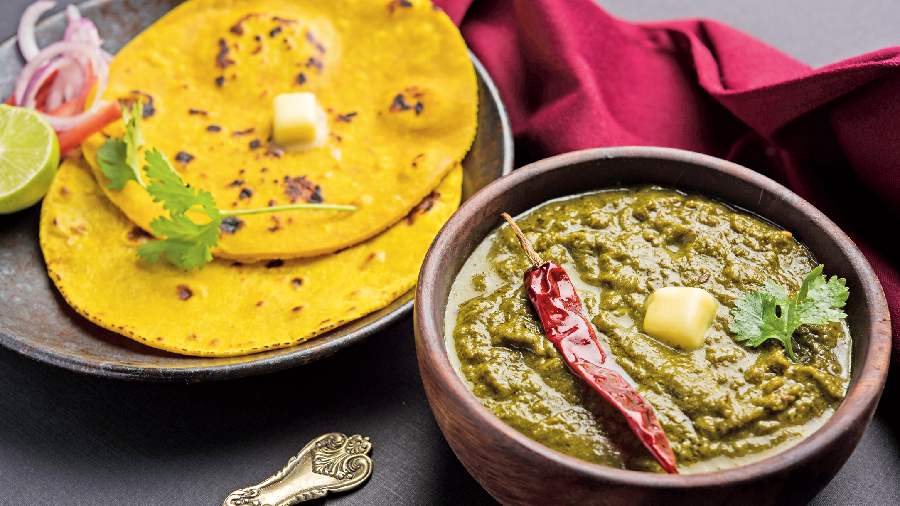Growing up, I remember us getting various topics to write essays on at our school. One among the most common, even till today, since my younger one just approached me for what she called a few ‘pointers’, the other day, is ‘My favourite season’. I grew up in western Uttar Pradesh and peak winters in that part of the country can often be quite relentless and unforgiving with the mercury regularly hovering around 2-3°C and we actually used to get surprise ‘too cold to go to school’ holidays. Even so, most students would choose winters to be their favourite season.
While everyone had their own reasons, based primarily on the obtainable mischief quotient, one classmate, I recall, wrote he loves winters since the canes of teachers hurt much less due to the layered clothes. Sadly, he got caned just for this reply! But most had one thing in common: the food.
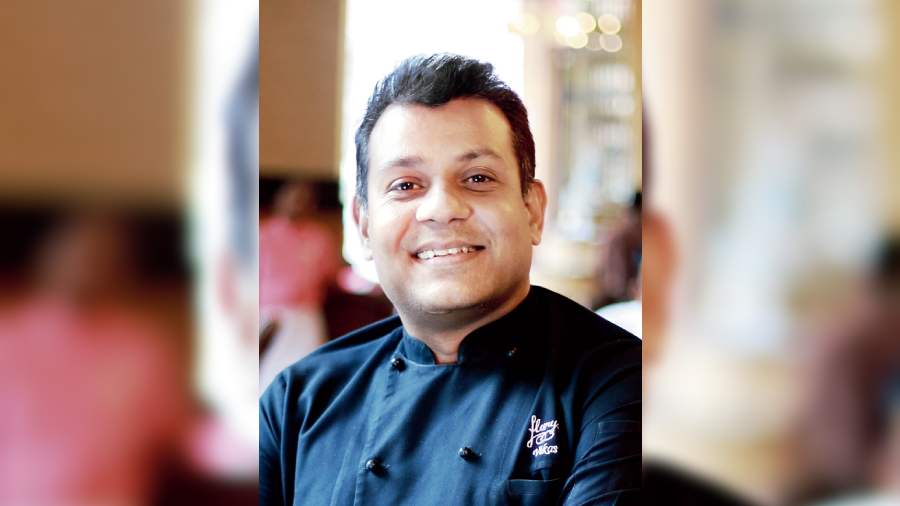
Chef Vikas Kumar
Yes, the winter foods. All across the country, the vegetable and grocery markets seem to get a glamorous makeover as soon as winter sets in. Whether those be the quintessential ‘green leafy’ vegetables that suddenly seem to be in abundance, or the mithai shops that start stocking halwas of gajar, moong and lauki and some having outdoor contraptions to serve steaming doodh-jalebi, it is true without a shred of doubt, winters are for foodies.
Closer home in Kolkata, which has mellow but most sought-after winters, the average Kolkatan seems to have found new vigour, especially towards the weekends or public holidays. The local park benches and parapets suddenly have a plethora of somewhat overdressed men and women vying for space and enjoying a steaming ‘bhar’ of cha, not to mention the larger public parks, zoos and picnic spots that routinely create new records in terms of total footfall.
As well as that, the food scene suddenly gets a huge uplift too, what with the Marwari community getting on with their gajak and til ka laddoos and the Bengalis with their iconic nolen gur desserts, kochuris and cakes. Yes, winter time in Kolkata is a season for cakes where all Kolkatans wish to enjoy their chilly evenings with a cup and a slice.
One of the reasons I think that Kolkatans go on a food, socialising and outdoor adventure overdrive during winters is simply because the winters are so brief here. Many times, just when you get around to planning a winter sojourn and gathering friends and relatives, the temperature is already in the mid-30s and the woollens one takes out need to go right back to their naphthalene balls.
While on the topic of winter special foods, let us discuss why or if we really feel hungrier and crave certain kinds of foods during winters. As it turns out, our bodies work harder to keep themselves warm during the winter months and hence need more fuel to keep going. This is quite understandable. There is apparently also something called SAD, or Seasonal Affective Disorder, which is another name for what is commonly known as ‘winter blues’ where people feel sad, anxious and depressed during winter months and counter it with eating more, basically looking for comfort in food.
In my view, and this is probably a simplistic one, people eat more during winter because there is more delicious food available! Come to think of it, is it really easy to not indulge in some hot buttered parathas, some frothy, sweet chai and a decadent jalebi while the sun is out and it is warm and bright? And this was just the breakfast, ditto for other meal periods.
The fact is, we do enjoy eating more in winter, and if the food was a true joy to all senses, winter is a joyful season indeed. Let us, therefore, discuss about a few dishes that are synonymous with the season of winter, the ones that bring memories of joy, of sunny days and of bonfires and early twilight.
Sarson ka saag
Whenever one thinks of winter foods, the top-of-the-head reaction is of indulging in the luscious, archetypal sarson ka saag, with its most famous accompaniment, the makki ki roti.
A true seasonal produce, the tender leaves of mustard are available for only a couple of months a year, in winters. Mustard is also among the few indigenous crops of India and is said to have been grown since 3000BCE!
The preparation includes painstakingly cleaning the mustard greens and cooking them for long hours in heavy-bottomed pans with the addition of many spices, fats, starch and more greens. The resultant concoction is a super flavourful, creamy and delicious dish that is simple, rustic and yet very delicate and rich.
This is traditionally had with butter-laden flatbread made with corn, called makki ki roti, fresh radish of the season and jaggery, which are both also winter season staples. In Kolkata, like in most parts of the country that has pronounced winters, many Indian speciality restaurants start to serve this winter delicacy from early winter, about now, right until fresh mustard greens are available, usually till mid-January.
Nihari
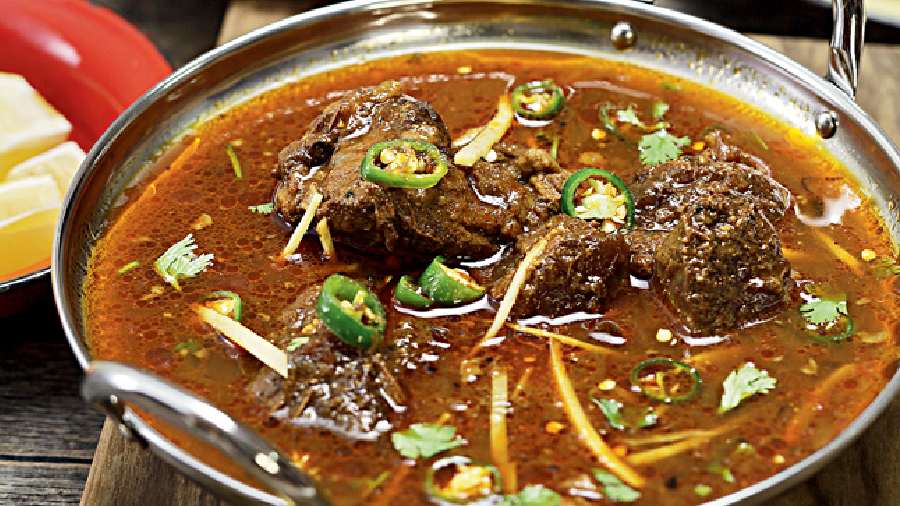
Mutton Nihari
Come winter and meat lovers across the country, even the late risers, get up early in the winter mornings to queue up outside the many Muslim restaurants at the break of dawn, oftentimes in darkness, to have the heavenly nihari, a dish developed by hakims, or physicians in today’s terminology, to Shah Jahan, the then emperor of India, in the historical city area of present-day Delhi, then known as Shahjahanabad.
Legend has it that the emperor consulted his hakims who used to supervise the production of food in royal kitchens to come up with a dish that could bring relief from the bitter cold and also act as a medicine for the people that suffered from seasonal cough and cold. The nihari, also known as nahari, is said to have gotten its name from the word nahaar, which meant ‘early morning’.
Nihari was meant to be had on an empty stomach, early morning and had spice combinations that would soothe winter ailments. It is said that nihari was a truly winter dish and the cooks that made nihari were the same that made bread, and in the months of summers and monsoons they made only bread. In fact, nihari was considered a working-class food and has only recently gotten the ‘delicacy’ tag, partly owing to the popularisation of Mughlai foods by bigger restaurants and hotels.
Nihari is made overnight with large cuts of beef, lamb or mutton including shanks and many different herbs and spices, flours and ghee. It is traditionally had with khameeri roti, literally translated as fermented bread.
Nolen gur: the golden elixir
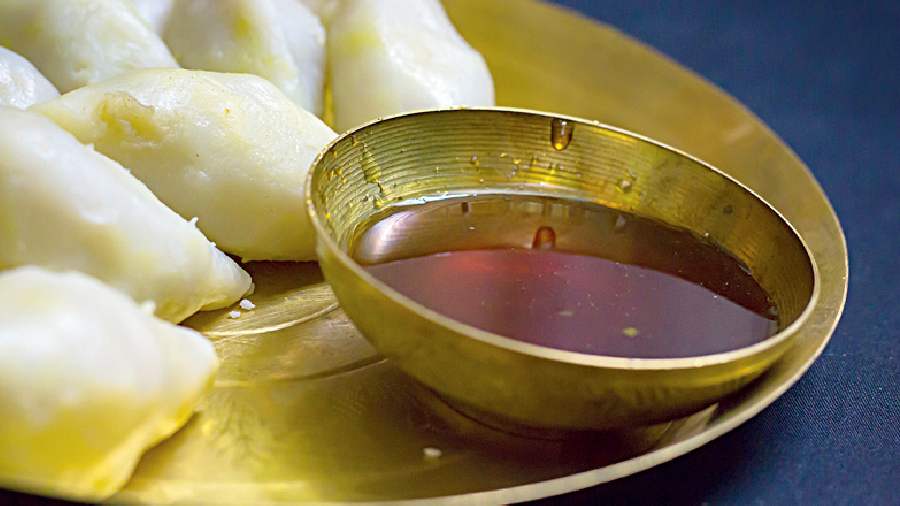
Nolen gur a delicacy
Talking about winters in Kolkata, we must mention the delectable, luscious, golden and deliciously sticky date palm jaggery, an ingredient which is the epitome of winter goodness in the truest sense. Uniquely fragrant and woody, and with a dainty, complex sweetness, nolen gur is the elixir of Bengali winter food traditions and is the most prized nature-made food product of the entire year, without a doubt.
Besides being the most sought-after ingredient by dessert makers, nolen gur also lends itself beautifully to modern contraptions, its silky texture and mellow sweetness can instantly lift up any dish and make it special. We at Flurys make full use of this most versatile gift of nature and use it in various recipes and dishes. Our Nolen Gur Cheesecake is almost iconic and this year we are also using nolen gur to flavour one of our special Christmas cakes, which is also our special flavour for this Christmas season.
Nolen Gur Cheesecake
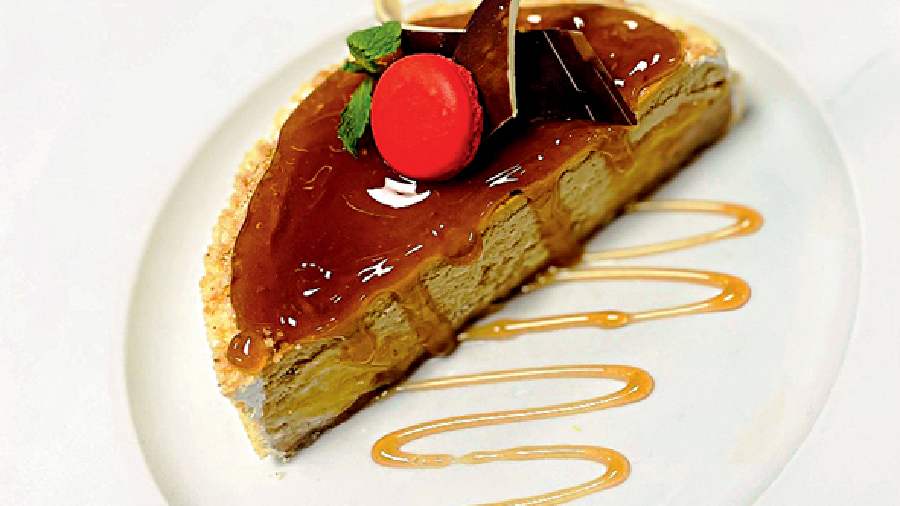
A tasty fusion
Nolen gur tastes most delicious in cream and or cheese-based desserts since the fragrant, almost caramelish sweetness goes very well with the richness of the cheese. Nolen Gur Cheesecake is an adaptation of the famous caramel cheesecake and is quite popular nowadays withmost bakeries making some version of it during the winter months.
INGREDIENTS
#For the cheesecake
- Cream cheese: 400g
- Nolen gur: 100g
- Fresh cream: 100ml
- Whole eggs: 2
- Lemon juice: 10ml
- Fresh orange zest: 5g
- Sour cream: 100ml
#For the base
- Digestive biscuits: 100g
- Butter melted: 50g
- Nolen gur: 50g
METHOD
- Mix the crushed digestive biscuits, melted butter and the warmed nolen gur. Line the base of a round cake ring with the same; bake in a moderate oven (170-180C) for about 10 minutes; allow cooling.
- For the cheesecake, mix the cream cheese, nolen gur, lemon juice and sour cream on slow speed until homogenous; do not overbeat.
- Add the whole eggs, orange zest and fresh cream and mix well.
- Pour on top of the prepared cake crust and bake in a medium oven (150C) for about 45-50 minutes; take out when completely set, lightly browned while still slightly wobbly in the centre.
- Cool and then refrigerate for minimum of 6 hours.ß Cut into wedges and serve with whipped cream and nolen gur.
Gajar ka halwa
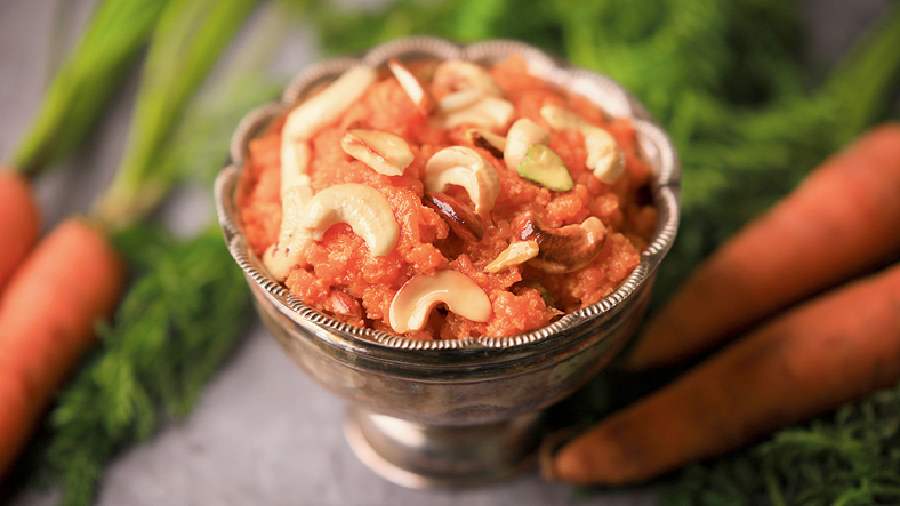
Gajar ka halwa - the lip-smacking dessert
Gajar ka halwaCome winter and the vegetable markets across the country seem to burst into colours. Adding chiefly to the colourfulness are the bright red, juicy carrots that are bountiful and are used in all cuisines and a plethora of dishes. The most well-known of those dishes, especially in the north of the country, is the extremely popular gajar ka halwa.
As a matter of fact, gajar ka halwa is among the best-known Indian desserts globally and is available in most Indian restaurants anywhere in the world. It is said that this beautiful dessert was first mentioned in the 13th century in the Middle East, in a book called Kitab-al-Tabikh or the book of dishes. The word halwa itself is said to be derived from the Arabic word hulv, meaning sweet.
In the Ottoman empire, sweet dishes were highly prized and the sultans even had separate kitchens to cook the sweets. Some credit the origin of the halwa to the Ottoman empire. In itself, gajar ka halwa is a simple sweet dish that is made with healthy ingredients such as ghee, nuts, carrots and sugar and is rich in many nutrients. In Kolkata, during winter, gajar ka halwa is available in almost all sweet shops, both Marwari and Bengali.
Aloo Gobhi

Vegetarian's paradise
Although we might not think much of this, but my personal winter food memories start with the humble aloo gobhi. It was an affordable bellwether for the start of the winter months as far as food was concerned. I remember, my father used to bring in new potatoes, green peas and cauliflower from the markets and proudly declare winters for all of us.
The first day the humble seasonal subji was prepared in our vegetarian household, it used to be almost feast-like, and I always used to rue how quickly the ubiquitous dish lost favour moving onwards with the season. Towards the end of the season, we were engrossed in making winter pickles of carrot, cauliflower and turnip, just because those were abundant and couldn’t be consumed quickly enough.
Aloo gobhi is also the most popular vegetarian dish from the Indian sub-continent and is found across the menus in all Indian restaurants globally, with slight variations. I was once asked to write a fancy description of the staple by my British chef for the ‘Indian week’ and I was really at a loss of words as to how to create a super sophisticated name for such a simple dish, but I guess calling it ‘A subtly spiced decadent concoction of fresh of the season potatoes, married with the princess of vegetables in an enchanting ethereal spice combination’ was good enough.
Vikas Kumar is the executive chef of Flurys. You can reach him at vkumar@flurys.com
